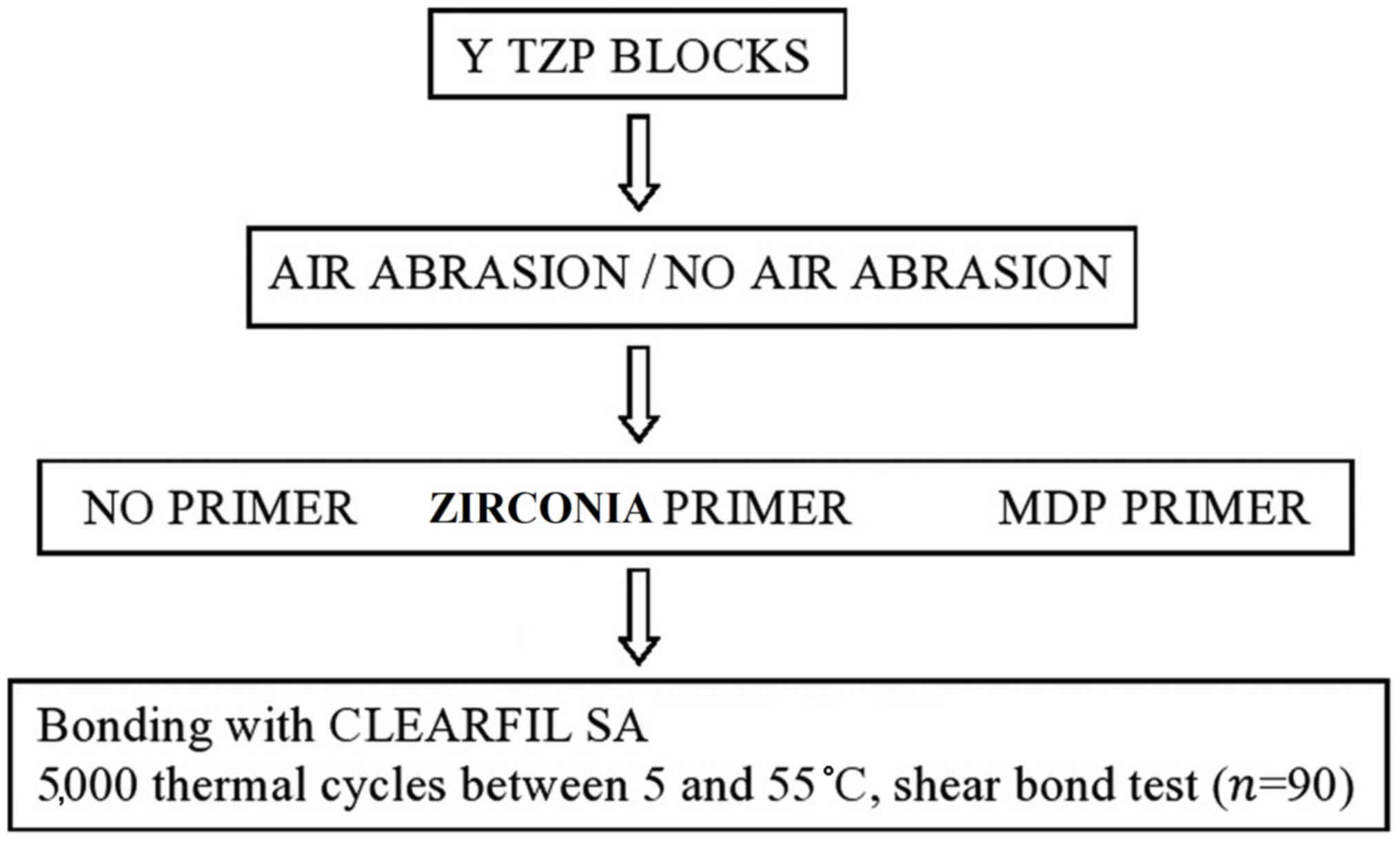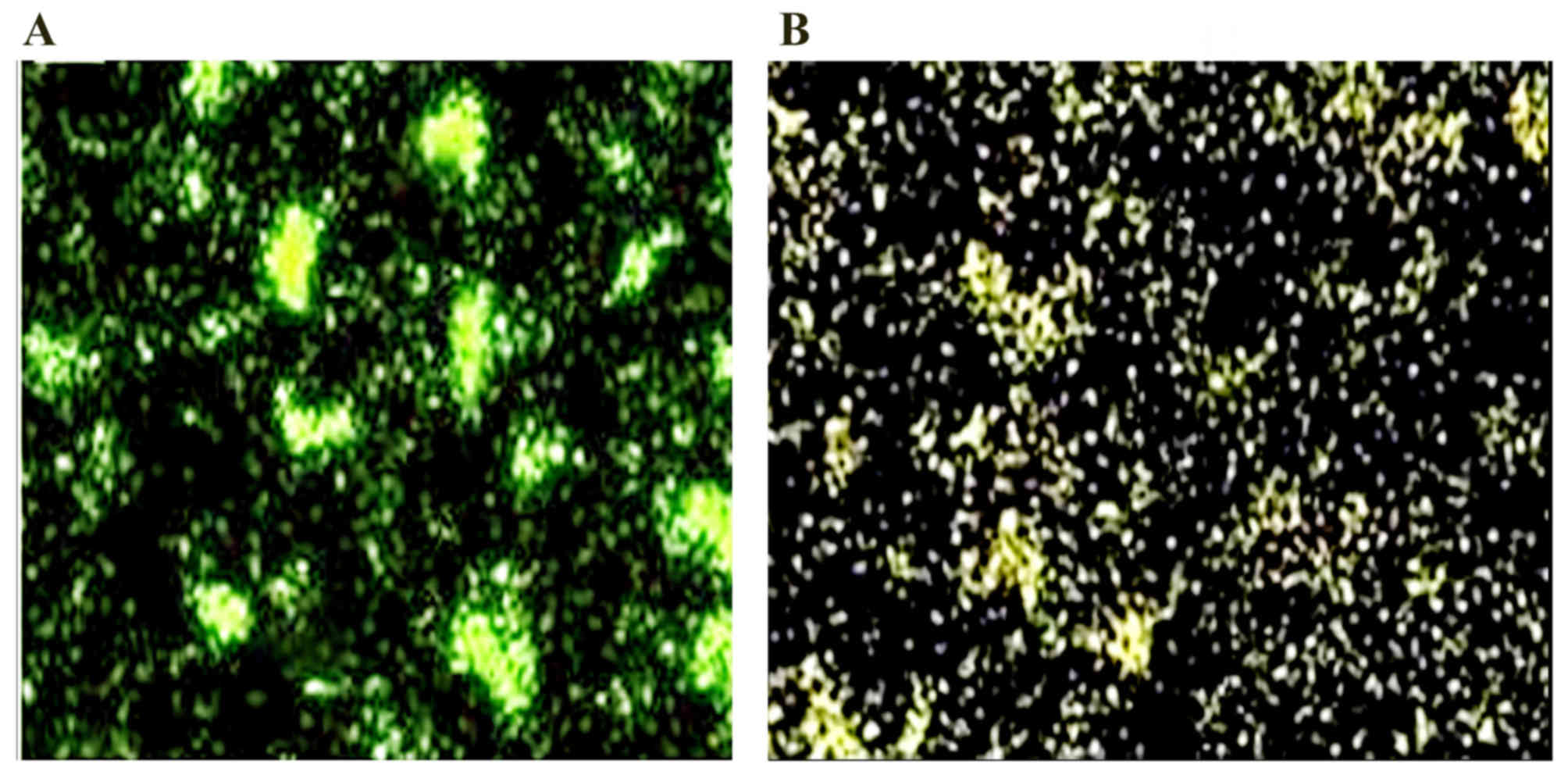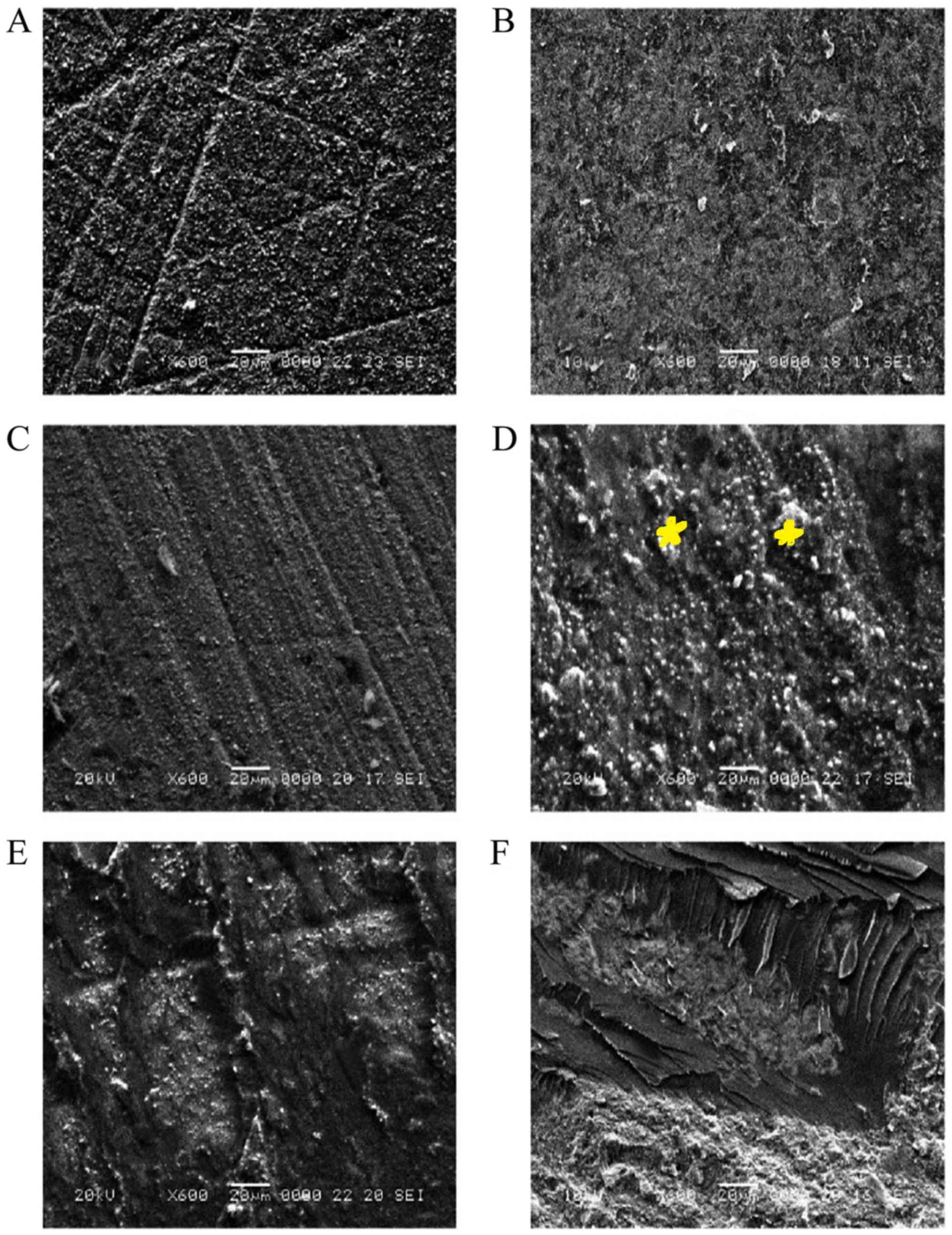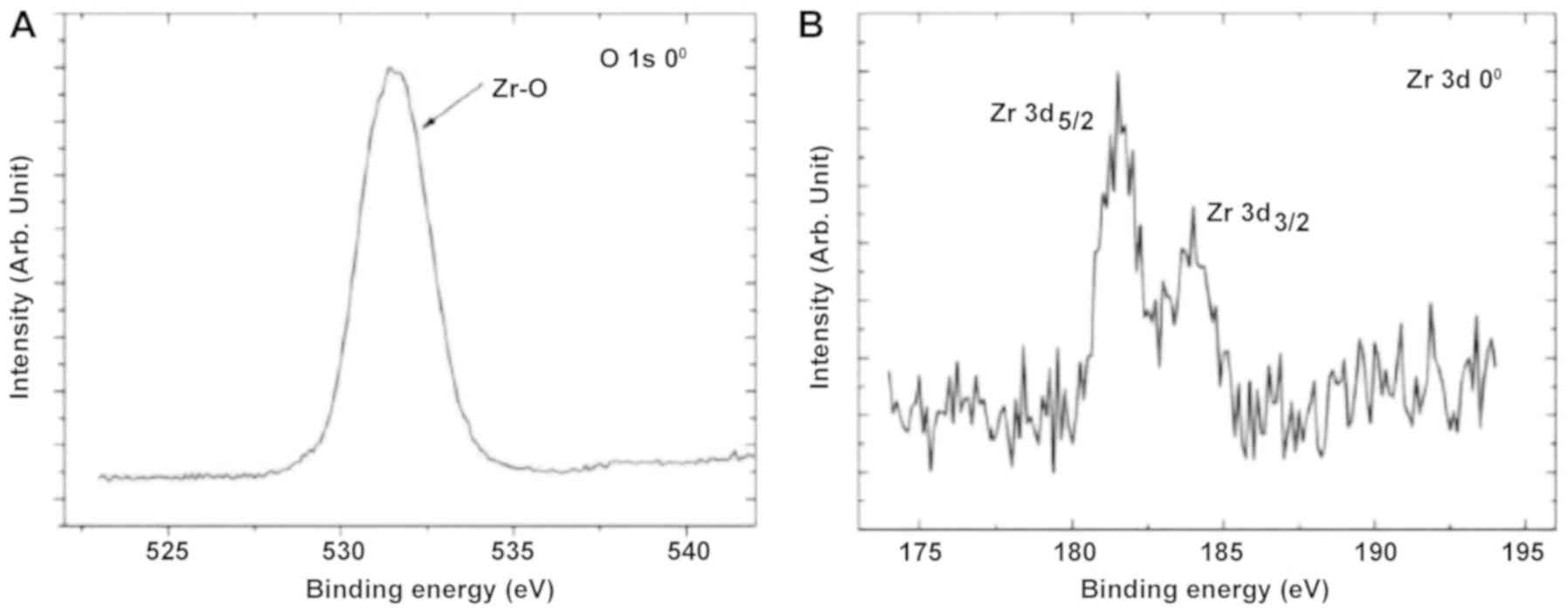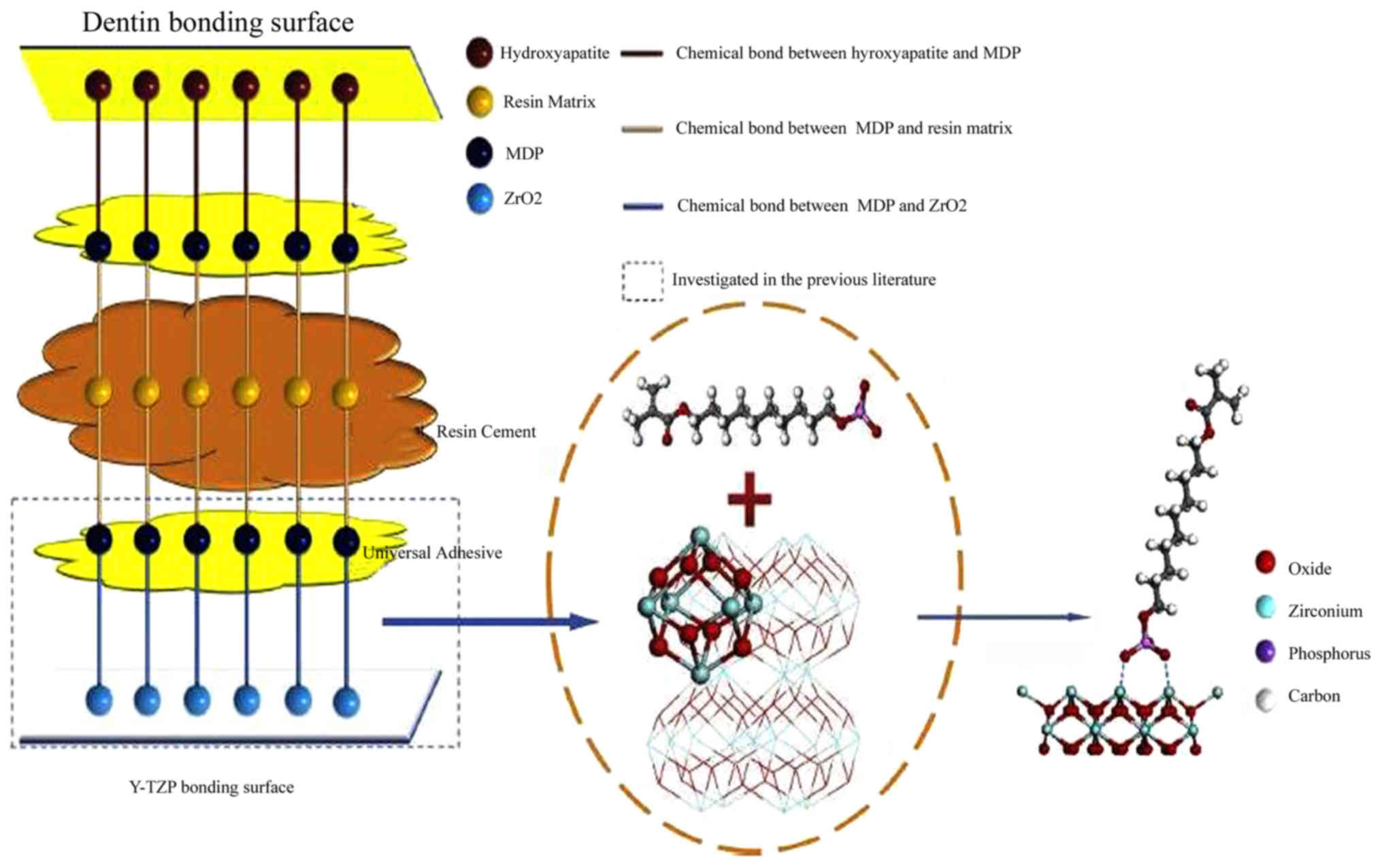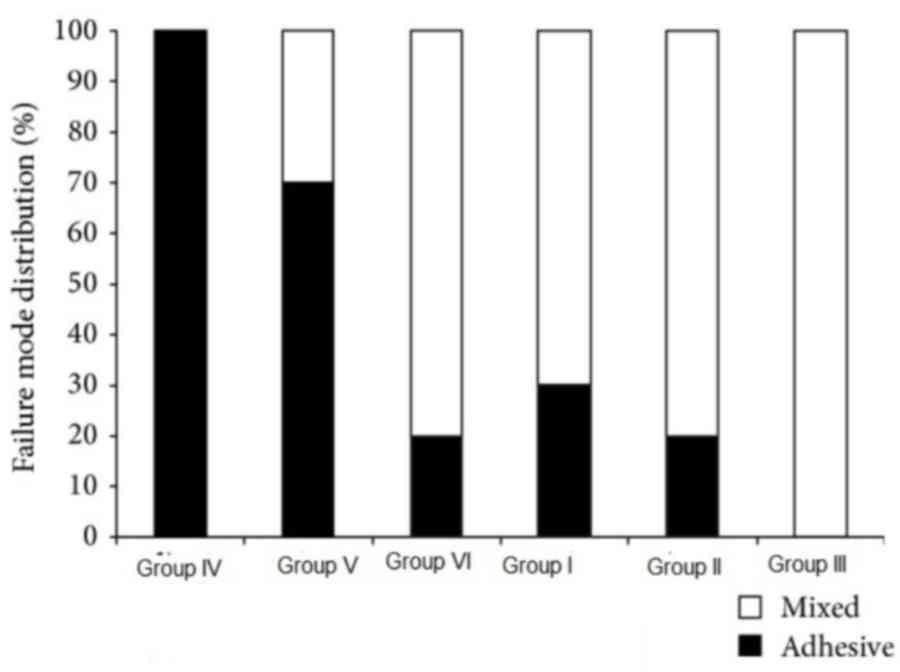Introduction
At present, there is a high demand for full ceramic
crowns on fixed partial dentures that are completely metal free.
The most commonly used ceramic core material is the
yttria-stabilized tetragonal zirconia polycrystal (Y-TZP) ceramic,
also known the zirconia crown, due to its optimal mechanical and
esthetic properties (1). These
crowns are highly resistant to fracture owing to their physical
properties (1). We propose that
ceramics offer long-term durability, however, saliva commonly
causes stress corrosion by reacting with the glass structure,
further causing decomposition. Ceramic crowns are also associated
with subcritical crack propagation (2,3). By
contrast, metal crowns and cores are entirely glass free due to
their polycrystalline microstructures, and, therefore offer
durability, stability and minimal risk of structural decomposition
(3). Few in vitro studies
have been conducted on this subject, and those conducted did not
reach definitive conclusions regarding the bond strength between
resin cement and zirconia. Researchers and scientists have
attempted to alter and modify the superficial surface properties of
zirconia by adopting numerous methodologies, including abrasion
with airborne particles (4,5). The use of tribochemical silica coating,
a relatively new method of air abrasion, has increased (4,5). This
method involves the use of small (~100 µm) aluminum oxide particles
coated with silica (4–7). When an appropriate blasting pressure is
applied, silica-coated aluminum particles are embedded into the
surface, which increases its sensitivity and chemical activity,
resulting in the formation of silane molecules (6). These molecules react further with water
to form the silanol group as well as the corresponding methoxy
group (8–10). Trimethoxysilyl-propyl methacrylate
(MPS) is the most commonly used silane in dental labs. Therefore,
in order to optimize compatibility, we propose that resin composite
materials i.e. MPS, should have one component that has been adapted
in conjugation with MPS silane.
The use of chair side abrasion techniques for air
abrasion is also increasing (7).
These techniques facilitate the increase in surface energy and
surface area, further enhancing the adhesion between resin cement
and zirconia while also increasing micromechanical retention
(8). Another advantage of this
method is that it decreases surface tension, thereby augmenting the
wettability of silane particles and improving adhesion. Following
chair side airborne abrasion of the silane particles, application
of primers containing 10-methacryloyloxydecyl dihydrogen phosphate
(MDP) significantly enhances bonding and durability (9). MDP-based primers also function as
adhesion promoters and are easy to use and apply, cost-efficient,
and do not require specialized equipment for their application
(10,11).
Various primers designed to enhance the bonding
strength of zirconia ceramic have been introduced (12). The use of MDP-containing primers on
the zirconia surface and the use of phosphate monomers as reliable
chemical agents for improving zirconia bonding have been supported
previously (13). A plausible
mechanism underlying this observation is the ability of phosphate
monomers to form chemical bonds with the zirconia surface,
resulting in polymerizable resin terminal end groups, for example
MPS, which facilitate cohesive bonding to the resin cement
(14).
The chemical adhesion potential of zirconia is low
due to inertness of its non polar surface, which impedes its
bonding with cements. However, increased availability of hydroxyl
groups was observed at the implant surface of a zirconia/aluminumna
no composite following treatment with a 15 M sodium hydroxide
solution. Additionally, durable bond strength may be achieved by
employing acid monomers, including MDP-based primers (13–15).
The most commonly used and appropriate resin cement
in prosthodontics is Panavia F2.0, which is composed of a
bi-functional monomer and MDP (15).
Several authors have suggested that Panavia F2.0 improves bonding
between the zirconia and resin cement (15). With recent advances in these
materials, the use of Y-TZP in restorative dentistry as a core
material for ceramic crowns and bridges has increased. Y-TZP
exhibits higher fracture toughness and strength compared with
dental ceramics. (16) Despite the
high fracture resistance of Y-TZP, resin cements are preferable to
conventional cements such as zinc polycarboxylate cement and
glass-ionomer cements for luting ceramic restorations, due to their
superior retention properties, increased fracture resistance and
good marginal seal (17). Various
other novel techniques have been developed to increase the surface
roughness of zirconia, including laser etching using erbium-doped
yttrium aluminum garnet laser, CO2, and neodymium-doped
yttrium aluminum garnet lasers (18).
Therefore, several methods including sandblasting,
plasma spraying, silane application, tribochemical silica coating,
acid etching and heat-based selective maturation etching techniques
have been applied to improve the adhesiveness and shear bond
strength (SBS) between zirconia and resin cement. None of these,
however, have proven satisfactory or yielded the desired results,
according to our analysis (19). The
aim of this study was to analyze the effects of MDP-containing
primers on the SBS between resin cement and zirconia.
Materials and methods
Specimen preparation
A total of 90 zirconia samples (15×10×4 mm) were
prepared using a low-concentration diamond blade from pre-sintered
Y-TZP blocks [97% zirconium dioxide stabilized with 3% yttria (3M
ESPE, Loughborough, UK; Table I)].
Each sample was initially ground for surface finishing and polished
using 600-grit silicon carbide abrasive burs under running water.
Each sample was further cleaned ultrasonically for 10 min
under-distilled water. Then the specimens were heated at 1,300°C
for 12 h. Finally, the samples were embedded in clear acrylic resin
blocks (ISOMET4000; Buehler, Lake Bluff, IL, USA). For cement
bonding, a single side of each block was left exposed. Surface
modifications, bonding procedures, evaluation of bond strength,
evaluation of failure, surface characterization and thermo dynamic
calculations, were performed as previously described (18,19).
 | Table I.Materials used in the present study
and their composition. |
Table I.
Materials used in the present study
and their composition.
| Material | Composition | Supplier |
|---|
| Yttria-stabilized
tetragonal zirconia polycrystal |
ZrO2+HfO2 (94.4wt%),
Y2O3 (5.2wt%), Al2 | 3M ESPE,
Loughborough, UK |
| Zirconia
primer | Ethanol (30–70%),
acetone (30–70%), silane (MPS) (1–10%) | Ivoclar Vivadent
Ltd., Leicester, UK |
| Clearfil SA
luting | Bis-GMA, EDGAMA,
MDP, barium glass, silica, sodium fluoride | Kuraray Noritake
Dental, Inc., Okayama, Japan |
| Z-PrimePlus | Ethanol (<90%),
biphenyl dimethacrylate (<10%), HEMA (<20%), MDP | BISCO Dental
Products, Schaumburg, IL, USA |
Surface modifications and bonding
procedure
All 90 samples were divided into six groups
comprising 15 samples each according to the surface treatment used.
Surface treatment of the specimens was performed by air abrasion
using aluminum oxide particles (particle size, 50 µm; stand off
distance, 25 mm; pressure, 2.8 bar; duration, 15 sec). The bonding
agent was Adper Scotchbond Multi-Purpose Plus Adhesive (3M
ESPE).
Treatment groups
Samples in group I were air abraded with aluminum
oxide. Samples in groups II and III were air abraded with aluminum
oxide and treated with Yttria-stabilized zirconia primer (zirconia;
Ivoclar Vivadent, Ltd., Leicester, UK) primer (group II) or Z-Prime
Plus MDP primer (Ivoclar Vivadent, Ltd.; group III). The samples in
group IV did not undergo any treatment or primer application. In
groups V and VI, the samples did not undergo any air abrasion but
were treated with zirconia primer (group V) or Z-Prime Plus MDP
primer (group VI; Fig. 1).
Bonding procedure
Prior to bonding of the Clearfil SA luting
self-adhesive resin cement (Kuraray Noritake Dental, Inc., Okayama,
Japan), the primers were applied for 1 min and air-dried.
Subsequently, Clearfil SA luting self-adhesive resin cement was
coated onto the zirconia crowns, with plastic tubes placed in the
center of the samples and resin composite filling the tube. Resin
cement was light-polymerized from opposite sides for 40 sec (DEMI™
light-curing unit; Kerr Corporation, Orange, CA, USA). All samples
were stored in distilled water for 24 h and then for 14 days.
Analyses were performed following the 24-h and 14-day storage
periods. Universal adhesive (Clearfil Universal Bond; Kuraray
Noritake Dental, Inc.) was also applied on the groups which were
airabrated.
Bond strength, failure, and fracture
surface evaluation
To evaluate the SBS between the Y-TZP block samples
and resin cement, the bonding machine (Lloyd Universal Testing
Machine; Ametek, Inc., Berwyn, PA, USA) was operated at a 0.5
mm/min crosshead speed; the adhesive interface of each specimen was
loaded into a jig of the universal testing machine (Lloyd Universal
Testing Machine; Ametek, Inc.) until failure occurred. The
corresponding software recorded the maximum stress (MPa) required
to produce a failure. The failure mode was observed with scanning
electron microscopy (SEM; magnification, ×150). An investigation of
the resin bonding on the zirconia and fractured surfaces was also
performed using SEM. An (SEM; S-4700 FE-SEM (Hitachi, Ltd., Tokyo,
Japan) was used with accelerating voltage of 10 kV, working
distance of 12 mm and spot size 50. The specimens were
sputter-coated with Sputter Coater SC7620 (Quorum Technologies,
Ltd., Laughton, UK). The samples were fixed in 2.5%
paraformaldehyde-2.5% glutaraldehyde in cacodylate sucrose buffer
(0.1 M cacodylate, 0.1 M sucrose, 5 mM CaCl, 5 mM MgCl, pH 7.2)
overnight at 4°C, rinsed in cacodylate buffer at pH 7.2 (3 changes
for 30 min at 4°C each) and then post-fixed in 1% osmium tetroxide
in the same buffer for 1 h at 4°C for the analysis of the
samples.
The SBS tests were performed using a universal
testing machine with a 50 kgf load cell, at a constant crosshead
speed of 0.5 mm/min. The force was concentrated on the Y-TZP cement
interface. The SBS (σ) value in MP a was determined using
the following equation:
σ=PA
Where P is the maximum load in N required to
produce a fracture, and A is the adhesive cross-sectional
area, expressed as πr2, where r is the
diameter of the bonded area divided by 2, measured using a digital
caliper (Mitutoyo Corporation, Tokyo, Japan).
The fractured surfaces were further inspected using
SEM, as detailed above, at ×150 magnification aided by an external
light source (Leica CL5150D; Leica Microsystems, Inc., Buffalo
Grove, IL, USA).
Using the grading method (20) to assess the failure mode in
zirconia/cement interfaces, failure was classified as: i) Mode 1,
where adhesive failure occurred between the ceramic and cement; or
ii) mode 2, where mixed failure defined as the combination of
adhesive and cohesive failures occurred. Representative specimens
from each group were examined using SEM at 150× magnification.
Surface characterization of the air
abraded Y-TZP surface
Fine-coated tribochemical silica with Silicatized
Cojet™ sand was applied to the Y-TZP surfaces and further air
abraded with aluminum oxide. Following air abrasion, the surface
was sputter coated with gold particles. All collected specimens
were analyzed by SEM, at 150× magnification as described above. An
energy-dispersive X-ray was used for micro-analysis of the
elemental distribution of alumina and silica on the sandblasted
Y-TZP surfaces.
In order to observe the chemical bond between Y-TZP
and MDP, the main functional adhesive composition in the current
testing primers or adhesives, Y-TZP-treated MDP ethanol solution
was detected using X-ray photoelectron spectroscopy (XPS; Physical
Electronics, Inc., Chanhassen, MN, USA) (21).
Thermodynamic calculations
Thermodynamic calculations were performed to
evaluate the stability between the zirconia and MDP primers.
Several studies have modeled the MDP-bound zirconia in the
tetragonal phase and analyzed the data under the standard
temperature and pressure (pressure, 1 atm; temperature, 298 K) to
evaluate the chemical bonds among MDP-bound zirconia, silicon oxide
and MPS (22,23). The thermodynamic calculations were
performed using the Own N-layered integrated molecular orbital and
molecular mechanic method in Gaussian 09 software (Gaussian, Inc.,
Wallingford, CT, USA).
Statistical analysis
Statistical analyses were performed using SPSS
software (version 19; IBM Corp., Armonk, NY, USA). The SBS values
were evaluated by one-way analysis of variance to analyze the
effects of chemical surface treatments of Y-TZP. A post hoc Tukey
test was applied to identify pairwise differences among the tested
groups. P<0.05 was considered to indicate a statistically
significant difference.
Results
Shear bond strength testing
Differences in SBS between groups are presented in
Table II. Group III (Z-PrimePlus
and air abrasion) exhibited an SBS of 14.56±2.6 MPa after 24 h, the
highest value among the groups during the first 24 h of storage,
and 12.97±1.8 MPa after 14 days. Significant differences were
observed between group III and group IV that received no surface
treatment or Z-Prime Plus primer (Table
II). Group II exhibited lower SBS than group III. Surface
treatment of specimens with aluminum oxide was associated with
higher SBS values compared with the groups that received no surface
treatment.
 | Table II.Shear bond strength (MPa) of
samples. |
Table II.
Shear bond strength (MPa) of
samples.
| Y-ZTP samples | Shear bond strength
after 24 h | Shear bond strength
after 14 days |
|---|
| Group I | 8.37±1.2 MPa | 6.04±0.6 MPa |
| Group II | 9.83±2.1 MPa | 7.34±1.3 MPa |
| Group III | 14.56±2.6
MPaa | 12.97±1.8
MPaa |
| Group IV | 3.97±0.9 MPa | 1.9±0.4 MPa |
| Group V | 6.02±1.2 MPa | 4.91±1.8 MPa |
| Group VI | 11.2±2.0 MPa | 8.30±2.2 MPa |
Air abrasion caused surface roughness with sharp
edges and grooves, according to SEM. Aluminum oxide-air abraded
surfaces treated with Z-Prime Plus primer had minimal fractures.
Representative SEM images (magnification, ×150) of Clearfil SA
luting cement residue on the contact area of the Y-TZP specimens
are presented in Figs. 2–4. The zirconia surfaces following
cementation in group IV (control group), having received no primer
treatment or air abrasion, and in group I (air abraded with
aluminum oxide) are presented in Fig. 2A
and B.
The zirconia surfaces following cementation in the
group treated with primer and without air abrasion (Fig. 3A), the group treated with primer and
air abrasion (Fig. 3B), the group
treated with Z-Prime Plus MDP ceramic primer without air abrasion
(Fig. 4A) and the group treated with
Z-Prime Plus MDP and air abrasion (Fig.
4B) are presented.
Surface characterization of air
abraded Y-TZP
The morphology of Y-TZP following different surface
treatments was observed by SEM. The results of the tribochemical
air-abraded process are illustrated in Figs. 5 and 6. The distribution of aluminum particles
was more dense and uneven (Fig. 5A)
compared with the silica particles, which were uniformly scattered,
consistent in pattern, and less dense, but this difference was not
marked (Fig. 5B).
The surface roughness of the surface-treated
zirconia and the surface morphology are illustrated in Fig. 6A-F. The surface roughness of Y-TZP
air abraded with alumina, MDP primer and tribochemical silica were
not different, however, the highest value was observed in the air
abraded with MDP primer group. The grooves and bridges of the
groups appeared to be irregularly distributed. Generally, air
abrasion combined with the use of the MDP primer caused the
roughest surfaces. Remaining resin cement is presented in Fig. 6A-F. Fig.
6F presents a unique ridged appearance, with more resin cement
residues attached to the Y-ZTP surface in the group with a
combination of air abrasion and Z-Prime Plus application.
Chemical bond characterization of
primers and adhesives on Y-TZP
X-ray photo electron spectroscopy was used to
analyze the chemical state of zirconia associated with MDP primer
surfaces (24,25). The chemical state of the Y-TZP-MDP
surface was analyzed by XPS, and its individual peaks are presented
in Fig. 7. The Zr-3d signal was
divided into two peaks centered at 181 and 184 eV, in parallel with
Zr-3d5/2 and Zr-3d3/2, respectively (21,24). The
Zr 3d5/2 state indicates complete oxidation of Zr4+, while Zr 3d3/2
represents spin-orbit splitting. The highest peak was observed at
~532 eV. The results indicated that ZrO and MDP were well formed,
with the highest percentage and ratio of ZrO (Fig. 7).
Thermodynamic calculations
The potential chemical bonds within the
sandwich-like zirconia-resin cement-dentin interface were
schematically illustrated in Fig. 8.
Two interfaces were present: One between the resin cement and
universal adhesive on the dentin surface and the other between the
resin cement and universal adhesive on the Y-TZP surface. on the
Y-TZP surface. Hydrolysis of the MDP and tetragonal zirconium
cluster complex is expressed as follows:
R−OPO2−Zr4O82−(aq)+2H2O(aq)
hydrolysis→ R−OP(OH)2(aq) +
Zr4O8(aq)+2OH−(aq) (21). This thermodynamic formula yielded an
equilibrium constant (K) of 4.9×1044. Hydrolysis of the
silica and SiO2 cluster complex is expressed as follows:
R−SiOMe−H10Si6O18(aq) +
2H2O(aq) → R−SiOMe(OH)2(aq) +
H12Si6O18(aq) (21).
This thermodynamic formula yielded
K=2.7×1015. According to the equilibrium constants of
the above formulae, the silica and SiO2 cluster complex
(lower K) (21) is more stable in
water than is the MDP and Y-TZP cluster complex.
Stereoscopic observations revealed adhesive failure
at the interface between the zirconia ceramic and bonding agent.
The fracture patterns exhibited mixed and adhesive failure
following 14 days of storage of the specimens (Fig. 9).
Discussion
The untreated Y-TZP surfaces (group IV) exhibited
the lowest bond strength. A high rate of adhesive failure was
observed by SEM and the Y-TZP surface had no remnants of luting
material, revealing a significantly lower SBS between the
self-adhesive resin cement and untreated Y-TZP surfaces. This may
be attributed to the inferior chemical bonding at the interface
between the components and the interface between the MDP component
of the Clearfil SA luting cement and the hydroxyl groups of the
Y-TZP ceramics (23,25).
Numerous studies have demonstrated low bond strength
associated with the use of conventional resin cements on untreated
Y-TZP ceramic surfaces (25–27). The results of the current study
indicated that bond strength was significantly enhanced by
treatment with MDP-based primers, as well as air abrasion.
Surface treatment without air abrasion (50-µm
particles) improved bond strength, regardless of whether the
zirconia under went primer pretreatment. These results are
consistent with those of previous studies (11,28).
Treatment with air abrasion enhances surface roughness and
increases surface energy, which in turn promotes resin cement flow
into micro-retentions. This aids micromechanical interlocking
between the resin cement and Y-TZP surface. Air abrasion may
generate hydroxyl groups on the Y-TZP surfaces, increasing the
reactivity of Y-TZP with phosphate monomers (11,28). The
results of the current study revealed that MDP-based Z-Prime Plus
promoted durable and reliable bonding with Y-TZP (20,28).
Even when the self-adhesive resin cement contains MDP as one of its
components, its functional monomer properties, including amount and
flow, are insufficient to increase the adhesion bond to Y-ZTP
without any pretreatment (22).
Therefore, Y-TZP surfaces are treated with MDP-based monomers in
general dental care, even if the self-adhesive resin cement
contains such monomers (22). A
direct bond between the phosphate ester group of the adhesive
monomers and zirconia oxides may be established chemically
(23,25). The bifunctional ends of MDP consist
of long, organic, hydrophobic chain molecules (11,28,29).
In the present study, the MDP-based product Z-Prime
Plus was associated with a markedly increased SBS compared with
phosphonic acid-based metal/zirconia primer; this is because MDP is
more effective than phosphonic acid acrylate in Y-TZP surface
treatment, even when the same phosphate monomer is included in both
products (19). In similar studies,
MDP-based primers exhibited increased bond strength with Y-TZP,
compared with other primers (30,31).
Adhesive failure was not limited to samples in group IV, and were
observed in the groups with air abrasion due to the absence of
chemical bond formation, as confirmed by SEM. The highest SBS was
attained with the combination of air abrasion and the MDP-based
primer. The chemical affinity in this group may have increased due
to enhanced surface wettability via air abrasion and increased bond
strength via treatment with MDP-based primers. In group III, all
specimens exhibited a mixed fracture pattern, which may be due to
the combined effects of the increased contact area with the Y-TZP
ceramic surface and the improved chemical interaction.
Magne et al (32) demonstrated that treatment with
Z-PrimePlus increases the SBS between zirconia ceramic and various
resin-based cements. Similar results were reported by Zandparsa
et al (33) and Shin et
al (11), who revealed that
combined application of Z-Prime Plus and air abrasion improved the
bond strength between zirconia and resin cement. Furthermore, Yi
et al (10) reported that the
application of Z-Prime Plus following air abrasion yielded the
strongest and most durable bond strength between zirconia ceramic
and resin cements, followed by Monobond Plus and silane primer
treatment following treatment with Cojet™, which was consistent
with the results of the current study. However, in a study by
Inokoshi et al (34),
pretreatment of zirconia with Clearfil ceramic primer or Monobond
Plus, both containing contain silane monomers, yielded the best
results, where low SBS values were observed with the use Z-Prime
Plus, in contrast to the results of the present study.
Air abrasion improves bond formation between
micro-roughened zirconia and resin cement (22,23). In
the control group IV, a high rate of failure was observed, which
may be attributed to the lower bond strength compared with all
other groups and poor chemical bonding between the components, as
no primer had been used.
Z-Prime Plus MDP primers yielded superior results in
terms of bonding to Y-TZP. The flow properties of the self-adhesive
resin cement Clearfil SA are insufficient to enhance adhesion to
zirconia ceramics (29). Therefore,
MDP functional monomers may be required for adhesion to zirconia
surfaces, even if the self-adhesive resin cement contains these
monomers. This is inconsistent with previous findings (35). The phosphate ester components of the
adhesive monomers are chemical agents that form direct bonds with
zirconia oxides (36).
The study conducted by Nagaoka et al
(29) in 2017 revealed that the
combination of 1H and 31P magic angle
spinning (MAS) nuclear magnetic resonance (NMR) and two dimensional
(2D) 1H→31P heteronuclear correlation
(HETCOR) NMR enabled description of the different chemical states
of the 10-MDP bonds with zirconia. These results are consistent
with data presented in the current study, where, compared with all
other groups, the application of MDP primers yielded the greatest
bond strength between Y-TZP ceramics and adhesive resin cement
(29). However, the study by Nagaoka
et al (29) aimed to analyze
the chemical interaction mechanism between 10-MDP and zirconia
using 1H and 31P MASNMR and
2D1H→31PHETCORNMR. By contrast, the current
study investigated the effects of MDP-based primers on shear bond
strength between resin cement and zirconia. This research may have
a clinical implication in dental prosthodontic research, indicating
that the application of MDP primers yielded highest bond strength
between Y-TZP ceramics and adhesive resin cement, compared with
other groups. By contrast, Sanohkan et al (12) concluded that the shear bond strength
values between zirconia ceramic and resin composite were not
significantly altered following treatment with various primers. The
mode of failure for all specimens was found to be the adhesive
failure at the interface between the ceramic and the bonding agent
(37). The results of the current
study revealed that the application of MDP primers yielded higher
bond strength between Y-TZP ceramics and adhesive resin cement when
compared with all other groups.
In the present study, a combination of air abrasion
and treatment with MDP-based products resulted in high bond
strength values and chemical affinity, due to enhanced surface
wettability via air abrasion and increased bond strength via the
treatment with MDP-based primers.
Acknowledgements
Not applicable.
Funding
No funding was received.
Availability of data and materials
The datasets used and/or analyzed during the current
study are available from the Central Library of Tianjin
Stomatological Hospital (Tianjin, China), and will be provided on
reasonable request.
Authors contributions
XY compiled the project proposal, aims and
objectives, and analyzed the results. XH wrote the manuscript. JG
collected the data and wrote the manuscript. PB collected the data
and analyzed results. JS formulated the aims and objectives,
analyzed the results and submitted the manuscript.
Ethics approval and consent to
participate
No patients or animals were included in this study.
The research was approved by the Ethical and Research Board
Committee of Medical College, International Medical Center, Tianjin
Stomatological Hospital (Tianjin, China; reference no.
TSH//RC/2015-12). All analyses were performed in accordance with
the relevant guidelines and regulations, as instructed by the
Ethical and Research Board Committee.
Patient consent for publication
Not applicable.
Competing interests
The authors declare that they have no competing
interests.
References
|
1
|
Al Amleh B, Lyons K and Swain M: Clinical
trials in zirconia: A systematic review. J Oral Rehabil.
37:641–652. 2010.PubMed/NCBI
|
|
2
|
De Sa Barbosa WF, Aguiar TR,
Francescantonio MD, Cavalcanti AN, de Oliveira MT and Giannini M:
Effect of water storage on bond strength of self adhesive resin
cements to zirconium oxide ceramic. J Adhes Dent. 15:145–150.
2013.PubMed/NCBI
|
|
3
|
Gonzaga CC, Cesar PF, Miranda WG Jr and
Yoshimura HN: Slow crack growth and reliability of dental ceramic.
Dent Mater. 27:394–406. 2011. View Article : Google Scholar : PubMed/NCBI
|
|
4
|
Melo RM, Souza RO, Dursun E, Monteiro EB,
Valandro LF and Bottino MA: Surface treatments of zirconia to
enhance bonding durability. Oper Dent. 40:636–643. 2015. View Article : Google Scholar : PubMed/NCBI
|
|
5
|
Re D, Augusti D, Augusti G and Giovannetti
A: Early bond strength to low pressures and blasted zirconia:
Evaluation of a self-adhesive cement. Eur J Esthet Dent. 7:164–175.
2012.PubMed/NCBI
|
|
6
|
Tanış MÇ, Akay C and Karakış D: Resin
cementation of zirconia ceramics with different bonding agents.
Biotechnol Biotechnol Equip. 29:363–367. 2015. View Article : Google Scholar : PubMed/NCBI
|
|
7
|
Murthy V, Manoharan, Balaji and
Livingstone D: Effect of four surface treatment methods on the
shear bond strength of resin cement to zirconia ceramics- A
comparative in vitro study. J Clin Diagn Res. 8:ZC65–ZC68.
2014.PubMed/NCBI
|
|
8
|
Blatz MB, Phark JH, Ozer F, Mante FK,
Saleh N, Bergler M and Sadan A: In vitro comparative bond strength
of contemporary self adhesive resin cements to zirconium oxide
ceramic with and without air particle abrasion. Clin Oral Investig.
14:187–192. 2010. View Article : Google Scholar : PubMed/NCBI
|
|
9
|
Jo EH, Huh YH, Ko KH, Park CJ and Cho LR:
Effect of liners and primers on tensile bond strength between
zirconia and resin-based luting agent. J Adv Prosthodont.
10:374–380. 2018. View Article : Google Scholar : PubMed/NCBI
|
|
10
|
Yi YA, Ahn JS, Park YJ, Jun SH, Lee IB,
Cho BH, Son HH and Seo DG: The effect of sandblasting and different
primers on shear bond strength between yttriatetragonal zirconia
polycrystal ceramic and a self-adhesive resin cement. Oper Dent.
40:63–71. 2015. View
Article : Google Scholar : PubMed/NCBI
|
|
11
|
Shin YJ, Shin Y, Yi YA, Kim J, Lee IB, Cho
BH, Son HH and Seo DG: Evaluation of the shear bond strength of
resin cement to Y-TZP ceramic after different surface treatments.
Scanning. 36:479–486. 2014. View Article : Google Scholar : PubMed/NCBI
|
|
12
|
Sanohkan S, Kukiattrakoon B, Larpboonphol
N, Sae-Yib T, Jampa T and Manoppan S: The effect of various primers
on shear bond strength of zirconia ceramic and resin composite. J
Conserv Dent. 16:499–502. 2013. View Article : Google Scholar : PubMed/NCBI
|
|
13
|
Lim MJ, Yu MK and Lee KW: The effect of
continuous application of MDP-containing primer and luting resin
cement on bond strength to tribochemical silica-coated Y-TZP.
Restor Dent Endod. 43:e192018. View Article : Google Scholar : PubMed/NCBI
|
|
14
|
Kitayama S, Nikaido T, Takahashi R, Zhu L,
Ikeda M, Foxton RM, Sadr A and Tagami J: Effect of primer treatment
on bonding of resin cements to zirconia ceramic. Dent Mater.
26:426–432. 2010. View Article : Google Scholar : PubMed/NCBI
|
|
15
|
Rohr N, Brunner S, Märtin S and Fischer J:
Influence of cement type and ceramic primer on retention of
polymer-infiltrated ceramic crowns to a one-piece zirconia implant.
J Prosthet Dent. 119:138–145. 2018. View Article : Google Scholar : PubMed/NCBI
|
|
16
|
Silva LHD, Lima E, Miranda RBP, Favero SS,
Lohbauer U and Cesar PF: Dental ceramics: A review of new materials
and processing methods. Braz Oral Res. 31 (Suppl 1):e582017.
View Article : Google Scholar : PubMed/NCBI
|
|
17
|
Thompson JY, Stoner BR, Piascik JR and
Smith R: Adhesion/cementation to zirconia and other non-silicate
ceramics: Where are we now. Dent Mater. 27:71–82. 2011. View Article : Google Scholar : PubMed/NCBI
|
|
18
|
Mirhashemi A, Sharifi N, Moharrami M and
Chiniforush N: Evaluation of different types of lasers in surface
conditioning of porcelains: A review article. J Lasers Med Sci.
8:101–111. 2017. View Article : Google Scholar : PubMed/NCBI
|
|
19
|
Ruyter EI, Vajeeston N, Knarvang T and
Kvam K: A novel etching technique for surface treatment of zirconia
ceramics to improve adhesion of resin-based luting cements. Acta
Biomater Odontol Scand. 3:36–46. 2017. View Article : Google Scholar : PubMed/NCBI
|
|
20
|
Kobayashi K, Komine F, Blatz MB, Saito A,
Koizumi H and Matsumura H: Influence of priming agents on the
short-term bond strength of an indirect composite veneering
material to zirconium dioxide ceramic. Quintessence Int.
40:545–555. 2009.PubMed/NCBI
|
|
21
|
Xie H, Li Q, Zhang F, Lu Y, Tay FR, Qian M
and Chen C: Comparison of resin bonding improvements to zirconia
between one-bottle universal adhesives and tribochemical silica
coating, which is better? Dent Mater. 32:403–411. 2016. View Article : Google Scholar : PubMed/NCBI
|
|
22
|
Ahn JS, Yi YA, Lee Y and Seo DG: Shear
bond strength of MDP-containing self-adhesive resin cement and
Y-TZP ceramics: Effect of phosphate monomer-containing primers.
Biomed Res Int. 2015:3892342015. View Article : Google Scholar : PubMed/NCBI
|
|
23
|
de Souza G, Hennig D, Aggarwal A and Tam
LE: The use of MDP-based materials for bonding to zirconia. J
Prosthet Dent. 112:895–902. 2014. View Article : Google Scholar : PubMed/NCBI
|
|
24
|
Valov I, Stoychev D and Marinova T: Study
of the kinetics of processes during electrochemical deposition of
zirconia from nonaqueous electrolytes. Electrochimica Acta.
47:4419–4431. 2002. View Article : Google Scholar
|
|
25
|
da Silva EM, Miragaya L, Sabrosa CE and
Maia LC: Stability of the bond between two resin cements and an
yttria-stabilized zirconia ceramic after six months of aging in
water. J Prosthet Dent. 112:568–575. 2014. View Article : Google Scholar : PubMed/NCBI
|
|
26
|
Lee SE, Bae JH, Choi JW, Jeon YC, Jeong
CM, Yoon MJ and Huh JB: Comparative shear-bond strength of six
dental self-adhesive resin cements to zirconia. Materials (Basel).
8:3306–3315. 2015. View Article : Google Scholar
|
|
27
|
Piwowarczyk A, Lauer HC and Sorensen JA:
The shear bond strength between luting cements and zirconia
ceramics after two pre-treatments. Oper Dent. 30:382–388.
2005.PubMed/NCBI
|
|
28
|
Kim JE, Kim JH, Shim JS, Roh BD and Shin
Y: Effect of surface treatment on shear bond strength between resin
cement and Ce-TZP/Al2O3. Biomed Res Int.
2016:75769422016.PubMed/NCBI
|
|
29
|
Nagaoka N, Yoshihara K, Feitosa VP, Tamada
Y, Irie M, Yoshida Y, Van Meerbeek B and Hayakawa S: Chemical
interaction mechanism of 10-MDP with zirconia. Sci Rep.
7:455632017. View Article : Google Scholar : PubMed/NCBI
|
|
30
|
Cabezaa A, Gómez-Alcántaraa M, del M,
Olivera-Pastora P, Sobradosb I, Sanz J, Sanz J, Xiao B, Morris RE,
Clearfield A and Arandaa MAG: From non-porous crystalline to
amorphous microporous metal (IV) bisphosphonates. Microporous and
Mesoporous Materials. 114:322–336. 2008. View Article : Google Scholar
|
|
31
|
Chen L, Suh BI, Brown D and Chen X:
Bonding of primed zirconia ceramics: Evidence of chemical bonding
and improved bond strengths. Am J Dent. 25:103–108. 2012.PubMed/NCBI
|
|
32
|
Magne P, Paranhos MP and Burnett LH Jr:
New zirconia primer improves bond strength of resin-based cements.
Dent Mater. 26:345–352. 2010. View Article : Google Scholar : PubMed/NCBI
|
|
33
|
Zandparsa R, Talua NA, Finkelman MD and
Schaus SE: An in vitro comparison of shear bond strength of
zirconia to enamel using different surface treatments. J
Prosthodont. 23:117–123. 2014. View Article : Google Scholar : PubMed/NCBI
|
|
34
|
Inokoshi M, Poitevin A, De Munck J,
Minakuchi S and Van Meerbeek B: Bonding effectiveness to different
chemically pre-treated dental zirconia. Clin Oral Investig.
18:1803–1812. 2014. View Article : Google Scholar : PubMed/NCBI
|
|
35
|
Della Bona A, Anusavice KJ and Shen C:
Microtensile strength of composite bonded to hot-pressed ceramics.
J Adhesive Dent. 2:305–313. 2000.
|
|
36
|
Kern M and Thompson VP: Bonding to glass
infiltrated alumina ceramic: Adhesive methods and their durability.
J Prosthet Dent. 73:240–249. 1995. View Article : Google Scholar : PubMed/NCBI
|
|
37
|
Miragaya L, Maia LC, Sabrosa CE, de Goes
MF and da Silva EM: Evaluation of self-adhesive resin cement bond
strength to yttria-stabilized zirconia ceramic (Y-TZP) using four
surface treatments. J Adhes Dent. 13:473–480. 2010.
|















